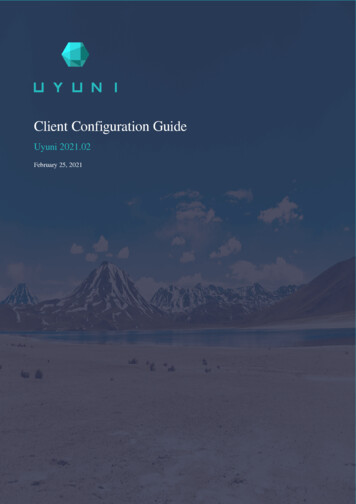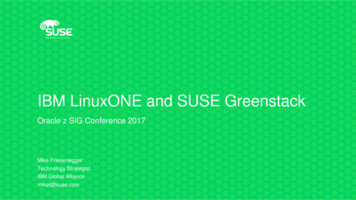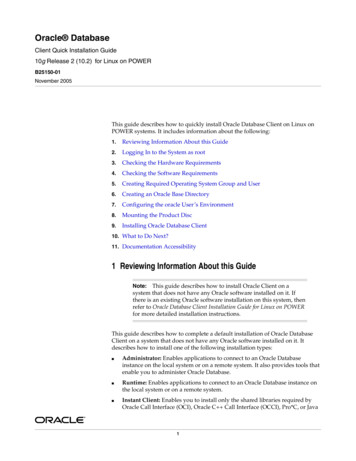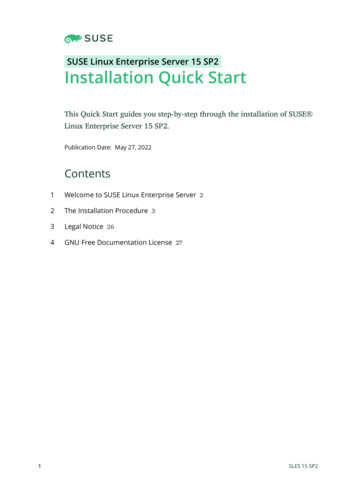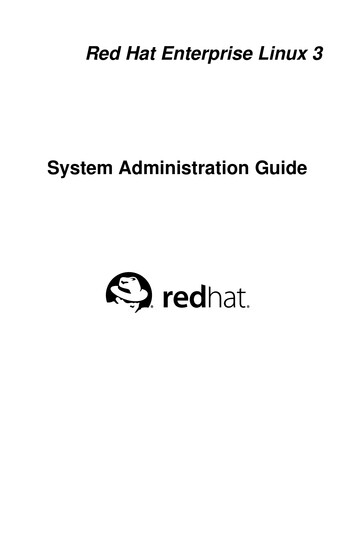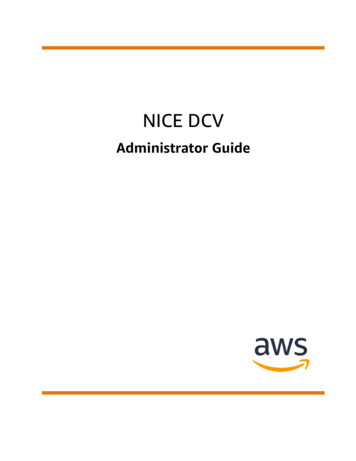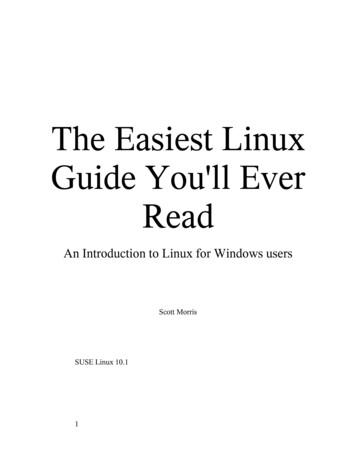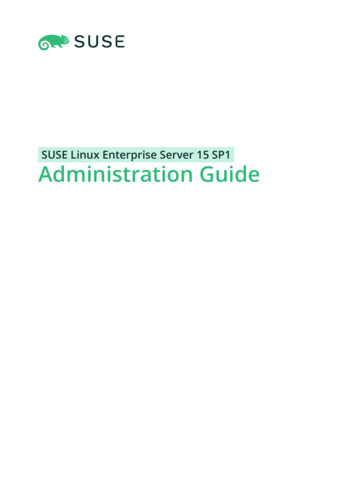
Transcription
SUSE Linux Enterprise Server 15 SP1Administration Guide
Administration GuideSUSE Linux Enterprise Server 15 SP1Covers system administration tasks like maintaining, monitoring and customizingan initially installed system.Publication Date: May 27, 2022SUSE LLC1800 South Novell PlaceProvo, UT 84606USAhttps://documentation.suse.comCopyright 2006– 2022 SUSE LLC and contributors. All rights reserved.
Permission is granted to copy, distribute and/or modify this document under the terms of the GNU FreeDocumentation License, Version 1.2 or (at your option) version 1.3; with the Invariant Section being thiscopyright notice and license. A copy of the license version 1.2 is included in the section entitled “GNUFree Documentation License”.For SUSE trademarks, see https://www.suse.com/company/legal/ . All other third-party trademarks are theproperty of their respective owners. Trademark symbols ( , etc.) denote trademarks of SUSE and itsaffiliates. Asterisks (*) denote third-party trademarks.All information found in this book has been compiled with utmost attention to detail. However, this doesnot guarantee complete accuracy. Neither SUSE LLC, its affiliates, the authors nor the translators shall beheld liable for possible errors or the consequences thereof.
Contents1About This Guide xxiiiAvailable Documentation xxiv2Improving the Documentation xxvi3Documentation Conventions xxvii4Product Life Cycle and Support xxviiiSupport Statement for SUSE Linux Enterprise Server xxix TechnologyPreviews xxxI11.1COMMON TASKS 1Bash and Bash Scripts 2What is “The Shell”? 2Bash Configuration Files 2 The Directory Structure 51.2Writing Shell Scripts 91.3Redirecting Command Events 101.4Using Aliases 111.5Using Variables in Bash 11Using Argument Variables 13 Using Variable Substitution 131.6Grouping and Combining Commands 141.7Working with Common Flow Constructs 15The if Control Command 15 Creating Loops with the for Command 161.8ivFor More Information 16Administration Guide
22.1sudo 17Basic sudo Usage 17Running a Single Command 17 Starting a Shell 18 EnvironmentVariables 192.2Configuring sudo 19Editing the Configuration Files 20 Basic sudoers ConfigurationSyntax 20 Rules in sudoers 222.3Common Use Cases 24Using sudo without root Password 24 Using sudo with X.OrgApplications 252.43More Information 26YaST Online Update 273.1The Online Update Dialog 283.2Installing Patches 293.3Viewing retracted patches 303.4Automatic Online Update 3144.15YaST 34Advanced Key Combinations 34YaST in Text Mode 365.1Navigation in Modules 375.2Advanced Key Combinations 395.3Restriction of Key Combinations 395.4YaST Command Line Options 40Installing Packages from the Command Line 40 Starting IndividualModules 40 Command Line Parameters of YaST Modules 41vAdministration Guide
66.1Managing Software with Command Line Tools 65Using Zypper 65General Usage 65 Using Zypper Subcommands 67 Installingand Removing Software with Zypper 67 UpdatingSoftware with Zypper 72 Identifying Processes andServices Using Deleted Files 78 Managing Repositorieswith Zypper 79 Querying Repositories and Packages withZypper 82 Showing Life Cycle Information 84 ConfiguringZypper 85 Troubleshooting 85 Zypper Rollback Feature on Btrfs FileSystem 85 For More Information 856.2RPM—the Package Manager 86Verifying Package Authenticity 86 Managing Packages: Install,Update, and Uninstall 87 Delta RPM Packages 88 RPMQueries 89 Installing and Compiling Source Packages 91 CompilingRPM Packages with build 93 Tools for RPM Archives and the RPMDatabase 9477.1System Recovery and Snapshot Management withSnapper 95Default Setup 96Types of Snapshots 97 Directories That Are Excluded fromSnapshots 97 Customizing the Setup 987.2Using Snapper to Undo Changes 102Undoing YaST and Zypper Changes 103 Using Snapper to RestoreFiles 1087.3System Rollback by Booting from Snapshots 110Snapshots after Rollback 112 Accessing and Identifying Snapshot BootEntries 112 Limitations 1147.4Enabling Snapper in User Home Directories 115Installing pam snapper and Creating Users 116 RemovingUsers 116 Manually Enabling Snapshots in Home Directories 1177.5Creating and Modifying Snapper Configurations 117Managing Existing Configurations 119viAdministration Guide
7.6Manually Creating and Managing Snapshots 122Snapshot Metadata 122 Creating Snapshots 124 Modifying SnapshotMetadata 125 Deleting Snapshots 1257.7Automatic Snapshot Clean-Up 127Cleaning Up Numbered Snapshots 127 Cleaning Up TimelineSnapshots 129 Cleaning Up Snapshot Pairs That Do NotDiffer 130 Cleaning Up Manually Created Snapshots 131 Adding DiskQuota Support 1317.8Showing Exclusive Disk Space Used by Snapshots 1327.9Frequently Asked Questions 1348Live kernel patching with KLP 1368.1Advantages of Kernel Live Patching 1368.2Kernel Live Patching overview 136Kernel Live Patching scope 138 Kernel Live Patching limitations 1388.3Activating Kernel Live Patching using YaST 1388.4Activating Kernel Live Patching from the command line 1398.5Performing Kernel Live Patching 140Checking expiration date of the live patch 1409viiTransactional Updates 1419.1Limitations of Technical Preview 1419.2Enabling transactional-update 1439.3Managing Automatic Updates 1439.4The transactional-update Command 1449.5Troubleshooting 146Administration Guide
1010.1Remote Graphical Sessions with VNC 147The vncviewer Client 147Connecting Using the vncviewer CLI 147 Connecting Using the vncviewerGUI 148 Notification of Unencrypted Connections 14810.2Remmina: the Remote Desktop Client 148Installation 148 Main Window 149 Adding RemoteSessions 149 Starting Remote Sessions 151 Editing, Copying, andDeleting Saved Sessions 152 Running Remote Sessions from the CommandLine 15210.3Configuring One-time Sessions on the VNC Server 153Available Configurations 154 Initiating a One-time VNCSession 155 Configuring One-time VNC Sessions 15510.4Configuring Persistent VNC Server Sessions 156VNC Session Initiated Using vncserver 157 VNC Session Initiated Usingvncmanager 15810.511File Copying with RSync 16411.1Conceptual Overview 16411.2Basic Syntax 16411.3Copying Files and Directories Locally 16511.4Copying Files and Directories Remotely 16611.5Configuring and Using an Rsync Server 16611.6For More Information 169II1212.1viiiConfiguring Encryption on the VNC Server 161BOOTING A LINUX SYSTEM 170Introduction to the Boot Process 171Terminology 171Administration Guide
12.2The Linux Boot Process 172The Initialization and Boot Loader Phase 172 The KernelPhase 173 The init on initramfs Phase 176 The systemd Phase 1781313.1UEFI (Unified Extensible Firmware Interface) 179Secure Boot 179Implementation on SUSE Linux Enterprise Server 180 MOK (MachineOwner Key) 182 Booting a Custom Kernel 183 Using Non-InboxDrivers 185 Features and Limitations 18613.214For More Information 187The Boot Loader GRUB 2 18814.1Main Differences between GRUB Legacy and GRUB 2 18814.2Configuration File Structure 188The File /boot/grub2/grub.cfg 189 The File /etc/default/grub 190 Scripts in /etc/grub.d 193 Mapping between BIOSDrives and Linux Devices 194 Editing Menu Entries during the BootProcedure 195 Setting a Boot Password 19614.3Configuring the Boot Loader with YaST 197Boot Loader Location and Boot Code Options 199 Adjusting the DiskOrder 200 Configuring Advanced Options 20114.4Differences in Terminal Usage on IBM Z 204Limitations 204 Key Combinations 20514.5Helpful GRUB 2 Commands 20714.6More Information 2081515.1The systemd Daemon 209The systemd Concept 209What Is systemd 209 Unit File 21015.2Basic Usage 211Managing Services in a Running System 211 Permanently Enabling/Disabling Services 213ixAdministration Guide
15.3System Start and Target Management 215Targets Compared to Runlevels 215 Debugging System StartUp 218 System V Compatibility 22115.4Managing Services with YaST 22215.5Customization of systemd 223Customizing Unit Files 223 Creating “Drop-in” Files 225 CreatingCustom Targets 22515.6Advanced Usage 226Cleaning Temporary Directories 226 SystemLog 227 Snapshots 227 Loading Kernel Modules 227 PerformingActions before Loading a Service 228 Kernel Control Groups(cgroups) 229 Terminating Services (Sending Signals) 230 ImportantNotes on the D-Bus Service 230 Debugging Services 23115.7III1616.116.217More Information 232SYSTEM 23332-Bit and 64-Bit Applications in a 64-Bit SystemEnvironment 234Runtime Support 234Kernel Specifications 235journalctl: Query the systemd Journal 23617.1Making the Journal Persistent 23617.2journalctl Useful Switches 23717.3Filtering the Journal Output 238Filtering Based on a Boot Number 238 Filtering Based on TimeInterval 238 Filtering Based on Fields 23917.4xInvestigating systemd Errors 240Administration Guide
17.5Journald Configuration 241Changing the Journal Size Limit 241 Forwarding the Journal to /dev/ttyX 241 Forwarding the Journal to Syslog Facility 24217.6Using YaST to Filter the systemd Journal 24217.7Viewing Logs in GNOME 24318update-alternatives: Managing Multiple Versions ofCommands and Files 24418.1Overview 24418.2Use Cases 24618.3Getting an Overview of Alternatives 24618.4Viewing Details on Specific Alternatives 24618.5Setting the Default Version of Alternatives 24718.6Installing Custom Alternatives 24818.7Defining Dependent Alternatives 2491919.1Basic Networking 252IP Addresses and Routing 255IP Addresses 255 Netmasks and Routing 25519.2IPv6—The Next Generation Internet 257Advantages 258 Address Types and Structure 259 Coexistence of IPv4and IPv6 263 Configuring IPv6 264 For More Information 26519.3Name Resolution 26619.4Configuring a Network Connection with YaST 267Configuring the Network Card with YaST 267 IBM Z: configuring networkdevices 27919.5Configuring a Network Connection Manually 281The wicked Network Configuration 281 Configuration Files 288 Testingthe Configuration 299 Unit Files and Start-Up Scripts 303xiAdministration Guide
19.6Basic Router Setup 30419.7Setting Up Bonding Devices 306Hotplugging of Bonding Slaves 30919.8Setting Up Team Devices for Network Teaming 310Use Case: Load Balancing with Network Teaming 313 Use Case: Failoverwith Network Teaming 314 Use Case: VLAN over Team Device 31519.9Software-Defined Networking with Open vSwitch 317Advantages of Open vSwitch 317 Installing Open vSwitch 318 Overviewof Open vSwitch Daemons and Utilities 318 Creating a Bridge with OpenvSwitch 320 Using Open vSwitch Directly with KVM 321 Using OpenvSwitch with libvirt 322 More information 32320Printer Operation 32420.1The CUPS Workflow 32520.2Methods and Protocols for Connecting Printers 32620.3Installing the Software 32620.4Network Printers 32720.5Configuring CUPS with Command Line Tools 32820.6Printing from the Command Line 32920.7Special Features in SUSE Linux Enterprise Server 330CUPS and Firewall 330 Browsing for Network Printers 331 PPD Files inVarious Packages 33120.8Troubleshooting 332Printers without Standard Printer Language Support 332 NoSuitable PPD File Available for a PostScript Printer 333 NetworkPrinter Connections 333 Defective Printouts without ErrorMessage 335 Disabled Queues 336 CUPS Browsing: Deleting PrintJobs 336 Defective Print Jobs and Data Transfer Errors 336 DebuggingCUPS 337 For More Information 337xiiAdministration Guide
21Graphical User Interface 33821.1X Window System 33821.2Installing and Configuring Fonts 338Showing Installed Fonts 340 Viewing Fonts 340 QueryingFonts 340 Installing Fonts 341 Configuring the Appearance ofFonts 34221.3GNOME Configuration for Administrators 351The dconf System 351 System-wide Configuration 351 MoreInformation 35221.4Switching Between Intel and NVIDIA Optimus GPUs with SUSEPrime 352Prerequisites 352 Installing and Using SUSE Prime 353 InstallingNVIDIA Drivers 35422Accessing File Systems with FUSE 35522.1Configuring FUSE 35522.2Mounting an NTFS Partition 35522.3For More Information 35623Managing Kernel Modules 35723.1Listing Loaded Modules with lsmod and modinfo 35723.2Adding and Removing Kernel Modules 358Loading Kernel Modules Automatically on Boot 358 Blacklisting KernelModules with modprobe 35924xiiiDynamic Kernel Device Management with udev 36124.1The /dev Directory 36124.2Kernel uevents and udev 36124.3Drivers, Kernel Modules and Devices 36224.4Booting and Initial Device Setup 362Administration Guide
24.5Monitoring the Running udev Daemon 36324.6Influencing Kernel Device Event Handling with udev Rules 364Using Operators in udev Rules 366 Using Substitutions in udevRules 367 Using udev Match Keys 368 Using udev Assign Keys 36924.7Persistent Device Naming 37024.8Files used by udev 37124.9For More Information 3722525.1Special System Features 373Information about Special Software Packages 373The bash Package and /etc/profile 373 The cronPackage 374 Stopping Cron Status Messages 375 Log Files:Package logrotate 375 The locate Command 375 The ulimitCommand 376 The free Command 377 Man Pages and InfoPages 377 Selecting Man Pages Using the man Command 377 Settingsfor GNU Emacs 37825.2Virtual Consoles 37925.3Keyboard Mapping 37925.4Language and Country-Specific Settings 380System Wide Locale Settings 381 Some Examples 382 Locale Settingsin /.i18n 383 Settings for Language Support 383 For MoreInformation 38426Using NetworkManager 38526.1Use Cases for NetworkManager 38526.2Enabling or Disabling NetworkManager 38626.3Configuring Network Connections 386Managing Wired Network Connections 388 Managing Wireless NetworkConnections 388 Configuring Your Wi-Fi/Bluetooth Card as an AccessPoint 389 NetworkManager and VPN 389xivAdministration Guide
26.4NetworkManager and Security 391User and System Connections 391 Storing Passwords andCredentials 392 Firewall Zones 39226.5Frequently Asked Questions 39326.6Troubleshooting 39426.7For More Information 39527Power Management 39627.1Power Saving Functions 39627.2Advanced Configuration and Power Interface (ACPI) 397Controlling the CPU Performance 398 Troubleshooting 39827.3Rest for the Hard Disk 40027.4Troubleshooting 401CPU Frequency Does Not Work 4012828.129VM Guest 402Adding and Removing CPUs 402Persistent Memory 40329.1Introduction 40329.2Terms 40429.3Use Cases 406PMEM with DAX 406 PMEM with BTT 40729.4Tools for Managing Persistent Memory 40729.5Setting Up Persistent Memory 409Viewing Available NVDIMM Storage 409 Configuring the Storage as aSingle PMEM Namespace with DAX 410 Creating a PMEM Namespace withBTT 412 Placing the Filesystem Journal on PMEM/BTT 41329.6xvFor More Information 414Administration Guide
IVSERVICES 41530Service Management with YaST 41631Time Synchronization with NTP 41831.1Configuring an NTP Client with YaST 418NTP Daemon Start 419 Type of the ConfigurationSource 419 Configure Time Servers 42031.2Manually Configuring NTP in the Network 42131.3Configure chronyd at Runtime Using chronyc 42231.4Dynamic Time Synchronization at Runtime 42231.5Setting Up a Local Reference Clock 42331.6Clock Synchronization to an External Time Reference (ETR) 42432The Domain Name System 42532.1DNS Terminology 42532.2Installation 42632.3Configuration with YaST 426Wizard Configuration 426 Expert Configuration 42932.4Starting the BIND Name Server 43732.5The /etc/named.conf Configuration File 439Important Configuration Options 440 Logging 441 Zone Entries 44232.6Zone Files 44332.7Dynamic Update of Zone Data 44632.8Secure Transactions 44732.9DNS Security 44832.10xviFor More Information 449Administration Guide
3333.1DHCP 450Configuring a DHCP Server with YaST 451Initial Configuration (Wizard) 451 DHCP Server Configuration (Expert) 45533.2DHCP Software Packages 46033.3The DHCP Server dhcpd 461Clients with Fixed IP Addresses 462 The SUSE Linux Enterprise ServerVersion 46333.434For More Information 464Sharing File Systems with NFS 46534.1Overview 46534.2Installing NFS Server 46634.3Configuring NFS Server 467Exporting File Systems with YaST 467 Exporting File SystemsManually 469 NFS with Kerberos 47234.4Configuring Clients 472Importing File Systems with YaST 472 Importing File SystemsManually 473 Parallel NFS (pNFS) 47534.535For More Information 477Samba 47835.1Terminology 47835.2Installing a Samba Server 47935.3Starting and Stopping Samba 48035.4Configuring a Samba Server 480Configuring a Samba Server with YaST 480 Configuring the ServerManually 48335.5Configuring Clients 487Configuring a Samba Client with YaST 487 Mounting SMB1/CIFS Shares onClients 487xviiAdministration Guide
35.6Samba as Login Server 48935.7Samba Server in the Network with Active Directory 49035.8Advanced Topics 491Automounting CIFS file system using systemd 491 Transparent FileCompression on Btrfs 493 Snapshots 49435.936For More Information 502On-Demand Mounting with Autofs 50336.1Installation 50336.2Configuration 503The Master Map File 503 Map Files 50536.3Operation and Debugging 506Controlling the autofs Service 506 Debugging the AutomounterProblems 50736.4Auto-Mounting an NFS Share 50836.5Advanced Topics 509/net Mount Point 509 Using Wild Cards to Auto-MountSubdirectories 509 Auto-Mounting CIFS File System 51037SLP 51137.1The SLP Front-End slptool 51137.2Providing Services via SLP 512Setting up an SLP Installation Server 51437.33838.1For More Information 514The Apache HTTP Server 515Quick Start 515Requirements 515 Installation 516 Start 51638.2Configuring Apache 517Apache Configuration Files 517 Configuring ApacheManually 520 Configuring Apache with YaST 525xviiiAdministration Guide
38.3Starting and Stopping Apache 53138.4Installing, Activating, and Configuring Modules 533Module Installation 534 Activation and Deactivation 534 Base andExtension Modules 534 Multiprocessing Modules 537 ExternalModules 539 Compilation 54038.5Enabling CGI Scripts 540Apache Configuration 541 Running an Example Script 541 CGITroubleshooting 54238.6Setting Up a Secure Web Server with SSL 543Creating an SSL Certificate 543 Configuring Apache with SSL 54738.7Running Multiple Apache Instances on the Same Server 54938.8Avoiding Security Problems 552Up-to-Date Software 552 DocumentRoot Permissions 552 File SystemAccess 553 CGI Scripts 553 User Directories 55338.938.10Troubleshooting 554For More Information 555Apache 2.4 555 ApacheModules 555 Development 555 Miscellaneous Sources 55639xixSetting Up an FTP Server with YaST 55739.1Starting the FTP Server 55839.2FTP General Settings 55839.3FTP Performance Settings 55939.4Authentication 55939.5Expert Settings 56039.6For More Information 560Administration Guide
4040.1Squid Caching Proxy Server 561Some Facts about Proxy Servers 561Squid and Security 562 Multiple Caches 562 Caching InternetObjects 56340.2System Requirements 563RAM 564 CPU 564 Size of the Disk Cache 564 Hard Disk/SSDArchitecture 56540.3Basic Usage of Squid 565Starting Squid 565 Checking Whether Squid Is Working 566 Stopping,Reloading, and Restarting Squid 568 Removing Squid 568 Local DNSServer 56940.4The YaST Squid Module 57040.5The Squid Configuration File 570General Configuration Options 571 Options for Access Controls 57440.6Configuring a Transparent Proxy 57640.7Using the Squid Cache Manager CGI Interface (cachemgr.cgi) 57740.8Cache Report Generation with Calamaris 58040.9For More Information 58041Web Based Enterprise Management Using SFCB 58141.1Introduction and Basic Concept 58141.2Setting Up SFCB 582Starting, Stopping and Checking Status for SFCB 583 Ensuring SecureAccess 58441.3SFCB CIMOM Configuration 586Environment Variables 586 Command Line Options 587 SFCBConfiguration File 58841.4Advanced SFCB Tasks 600Installing CMPI Providers 600 Testing SFCB 604 Command Line CIMClient: wbemcli 606xxAdministration Guide
41.5V4242.1For More Information 608TROUBLESHOOTING 609Help and Documentation 610Documentation Directory 610SUSE Manuals 611 Package Documentation 61142.2Man Pages 61242.3Info Pages 61342.4Online Resources 61443Gathering System Information for Support 61543.1Displaying Current System Information 61543.2Collecting System Information with Supportconfig 616Creating a Service Request Number 617 Upload Targets 617 Creatinga Supportconfig Archive with YaST 617 Creating a SupportconfigArchive from Command Line 620 Understanding the Output ofsupportconfig 620 Common Supportconfig Options 621 Overview ofthe Archive Content 62243.3Submitting Information to Global Technical Support 62643.4Analyzing System Information 628SCA Command Line Tool 628 SCA Appliance 630 Developing CustomAnalysis Patterns 64143.5Gathering Information during the Installation 64243.6Support of Kernel Modules 642Technical Background 643 Working with Unsupported Modules 64343.74444.1xxiFor More Information 644Common Problems and Their Solutions 646Finding and Gathering Information 646Administration Guide
44.2Boot Problems 649The GRUB 2 Boot Loader Fails to Load 649 No GraphicalLogin 650 Root Btrfs Partition Cannot Be Mounted 650 Force CheckingRoot Partitions 65044.3Login Problems 651Valid User Name and Password Combinations Fail 651 Valid User Nameand Password Not Accepted 652 Login to Encrypted Home PartitionFails 654 Login Successful but GNOME Desktop Fails 65544.4Network Problems 656NetworkManager Problems 66044.5Data Problems 660Managing Partition Images 661 Using the Rescue System 66144.6xxiiIBM Z: Using initrd as a Rescue System 668AAn Example Network 670BGNU Licenses 671Administration Guide
About This GuideThis guide is intended for use by professional network and system administrators during theoperation of SUSE Linux Enterprise. As such, it is solely concerned with ensuring that SUSELinux Enterprise is properly configured and that the required services on the network are available to allow it to function properly as initially installed. This guide does not cover the processof ensuring that SUSE Linux Enterprise offers proper compatibility with your enterprise's application software or that its core functionality meets those requirements. It assumes that a fullrequirements audit has been done and the installation has been requested, or that a test installation for such an audit has been requested.This guide contains the following:Support and Common TasksSUSE Linux Enterprise offers a wide range of tools to customize various aspects of thesystem. This part introduces a few of them. A breakdown of available device technologies,high availability configurations, and advanced administration possibilities introduces thesystem to the administrator.SystemLearn more about the underlying operating system by studying this part. SUSE Linux En-terprise supports several hardware architectures and you can use this to adapt your ownapplications to run on SUSE Linux Enterprise. The boot loader and boot procedure information assists you in understanding how your Linux system works and how your owncustom scripts and applications may blend in with it.ServicesSUSE Linux Enterprise is designed to be a network operating system. It offers a wide rangeof network services, such as DNS, DHCP, Web, proxy, and authentication services. It al-so integrates well into heterogeneous environments, including MS Windows clients andservers.Mobile ComputersLaptops, and the communication between mobile devices like PDAs, or cellular phonesand SUSE Linux Enterprise need some special attention. Take care for power conservationand for the integration of different devices into a changing network environment. Also getin touch with the background technologies that provide the needed functionality.TroubleshootingxxiiiSLES 15 SP1
Provides an overview of finding help and additional documentation when you need moreinformation or want to perform specific tasks. There is also a list of the most frequentproblems with explanations of how to x them.1 Available DocumentationNote: Online Documentation and Latest UpdatesDocumentation for our products is available at https://documentation.suse.com/ , whereyou can also nd the latest updates, and browse or download the documentation in various formats. The latest documentation updates are usually available in the English version of the documentation.Note: Manual PagesMany commands are described in detail in their manual pages. You can view manualpages by running the man command followed by a specific command name. If the mancommand is not installed on your system, install it by running zypper install man .The following documentation is available for this product:Article “Installation Quick Start”This Quick Start guides you step-by-step through the installation of SUSE Linux Enterprise Server 15 SP1.Book “Deployment Guide”This guide details how to install single or multiple systems, and how to exploit the prod-uct-inherent capabilities for a deployment infrastructure. Choose from various approach-es: local installation from physical installation media, customizing the standard installa-tion images, network installation server, mass deployment using a remote-controlled, highly-customized, automated installation process, and initial system configuration.Book “Administration Guide”Covers system administration tasks like maintaining, monitoring and customizing an initially installed system.Book “Virtualization Guide”xxivAvailable DocumentationSLES 15 SP1
Describes virtualization technology in general, and introduces libvirt—the unified interface to virtualization—and detailed information on specific hypervisors.Book “Storage Administration Guide”Provides information about how to manage storage devices on a SUSE Linux EnterpriseServer.Book “AutoYaST Guide”AutoYaST is a system for unattended mass deployment of SUSE Linux Enterprise Serversystems using an AutoYaST profile containing installation and configuration data. Themanual guides you through the basic steps of auto-installation: preparation, installation,and configuration.Book “Security and Hardening Guide”Introduces basic concepts of system security, covering both local and network securityaspects. Shows how to use the product inherent security software like AppArmor, SELinux,or the auditing system that reliably collects information about any security-relevant events.Supports the administrator with security-related choices and decisions in installing andsetting up a secure SUSE Linux Enterprise Server and additional processes to further secureand harden that installation.Book “System Analysis and Tuning Guide”An administrator's guide for problem detection, resolution and optimization. Find how toinspect and optimize your system by means of monitoring tools and how to efficientlymanage resources. Also contains an overview of common problems and solutions and ofadditional help and documentation resources.Book “Repository Mirroring Tool Guide”An administrator's guide to Subscription Management Tool—a proxy system for SUSE Cus-tomer Center with repository and registration targets. Learn how to install and configure alocal SMT server, mirror and manage repositories, manage client machines, and configureclients to use SMT.Book “GNOME User Guide”Introduces the GNOME desktop of SUSE Linux Enterprise Server. It guides you throughusing and configuring the desktop and helps you perform key tasks. It is intended mainlyfor end users who want to make efficient use of GNOME as their default desktop.The release notes for this product are available at https://www.suse.com/releasenotes/ .xxvAvailable DocumentationSLES 15 SP1
2 Improving the DocumentationYour feedback and contributions to this documentation are welcome. The following channelsfor giving feedback are available:Service Requests and SupportFor services and support options available for your product, see https://www.suse.com/support/.To open a service request, you need a SUSE subscription registered at SUSE CustomerCenter. Go to https://scc.suse.com/support/requests , log in, and click Create New.Bug ReportsReport issues with the documentation at https://bugzilla.suse.com/ . To simplify thisprocess, you can use the Report Documentation Bug links next to headlines in the HTML ver-sion of this document. These preselect the right product and category in Bugzilla and adda link to the current section. You can start typing your bug report right away. A Bugzillaaccount is required.ContributionsTo contribute to this documentation, use the Edit Source links next to headlines in theHTML version of this document. They take you to the source code on GitHub, where youcan open a pull request. A GitHub account is required.Note: Edit Source only available for EnglishThe Edit Source links are only available for the English version of each document.For all other languages, use the Report Documentation Bug links instead.For more information about the documentation environment used for this documentation,see the repository's README at docMailYou can also report errors and send feedback concerning the documentation to doc-team@suse.com . Include the document title, the product version, and the publication dateof the document. Additionally, include the relevant section number and title (or providethe URL) and provide a concise description of the problem.xxviImproving the DocumentationSLES 15 SP1
3 Documentation ConventionsThe following notices and typographical conventions are used in this documentation:/etc/passwd : directory names and le namesPLACEHOLDER : replace PLACEHOLDER with the actual valuePATH : the environment variable PATHls , --help : commands, options, and parametersuser : users or groupspackage name : name of a packageAlt,Alt– F1 : a key to press or a key combination; keys are shown in uppercase as ona keyboardFile, File Save As: menu items, buttonsAMD/IntelThis paragraph is only relevant for the AMD64/Intel 64 architecture. The ar-r
Administration Guide SUSE Linux Enterprise Server 15 SP1 Covers system administration tasks like maintaining, monitoring and customizing an initially installed system. Publication Date: February 04, 2022 SUSE LLC 1800 South Novell
